Highlights of the Collection

This is a paleolithic hunting tool that was inserted into a tool made out of wood or other materials. Similar to a small arrowhead, there is a tang on the bottom. The body has traces of the blade that was removed symmetrically.

Obsidian is a volcanic rock whose name in Korean means a “black, shiny rock.” It is formed when lava flowing from a volcanic eruption rapidly cools on the Earth’s surface. Because it can be easily split into sharp edges, it was mainly used to make arrowheads. Obsidian arrowheads dating from the Neolithic period are commonly found on the south coast and the northeastern region, and their origins can be traced back to Baekdusan Mountain and Kyushu, Japan.
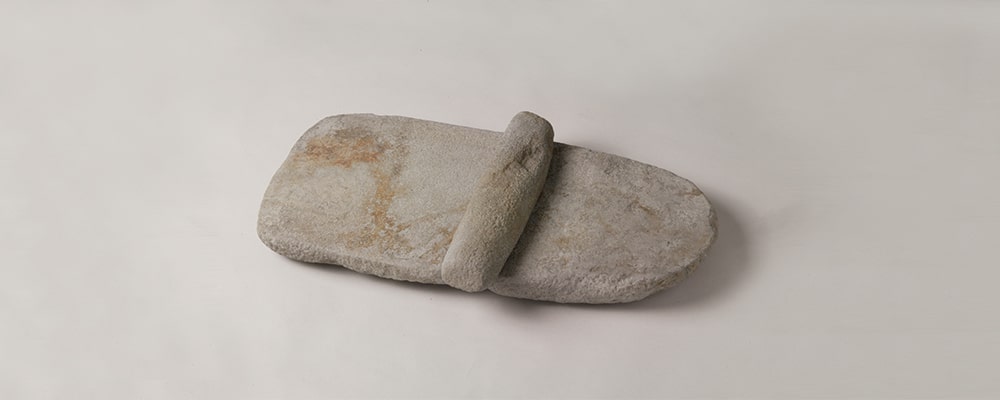
This is a primitive millstone used to remove the peel from fruits and hull from grains and to pulverize them into powder. A broad quern and a club-shaped pestle are used together. These tools began to be used in the Neolithic period, and they were employed to process grains during the Bronze Age, which was characterized by an agrarian society. They were later replaced by mortars.
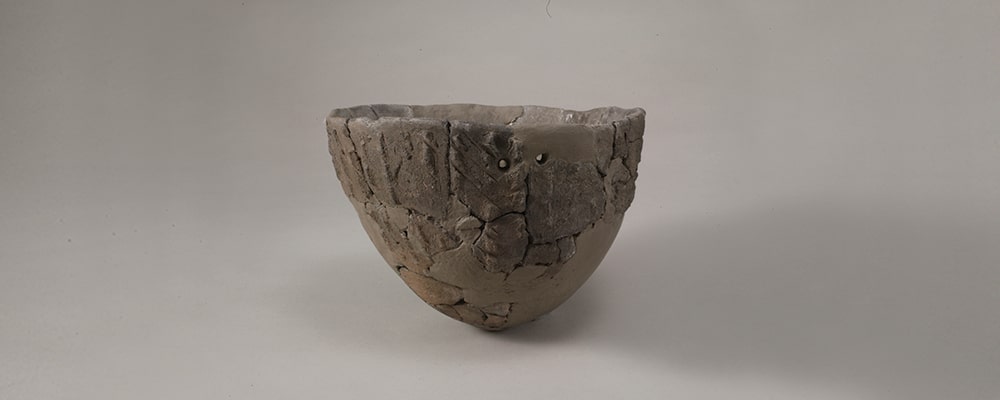
This is a type of earthenware decorated with a clay band on the surface or a pattern created by pinching the surface. The patterns seen on Neolithic pottery served to strengthen the wares, with different patterns created on the mouth, body and bottom. This type of pottery features a wide range of shapes including fingernail, triangle, rainbow, claw and fishbone, and the designs became increasingly simplified over time.
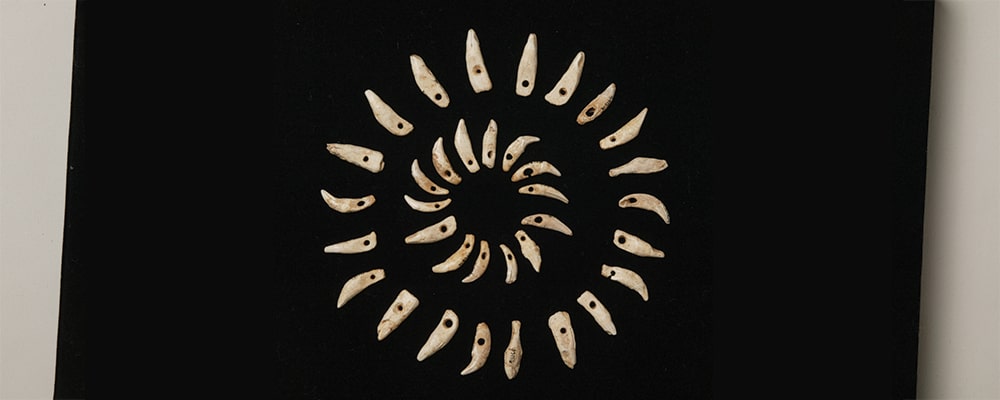
This was found on a human bone in the Tomb No. 7 of the Yeondaedo Shellmound in Tongyeong. The wearer is speculated to be a male measuring approximately 160cm in height. 32 pieces were found on his left leg, 40 on his right leg, and 48 below his right leg. This particular anklet was made out of dolphin, otter and raccoon teeth.

Obsidian is a volcanic rock whose name in Korean means a “black, shiny rock.” It is formed when lava flowing from a volcanic eruption rapidly cools on the Earth’s surface. Because it can be easily split into sharp edges, it was mainly used to make arrowheads. Obsidian arrowheads dating from the Neolithic period are commonly found on the south coast and the northeastern region, and their origins can be traced back to Baekdusan Mountain and Kyushu, Japan.
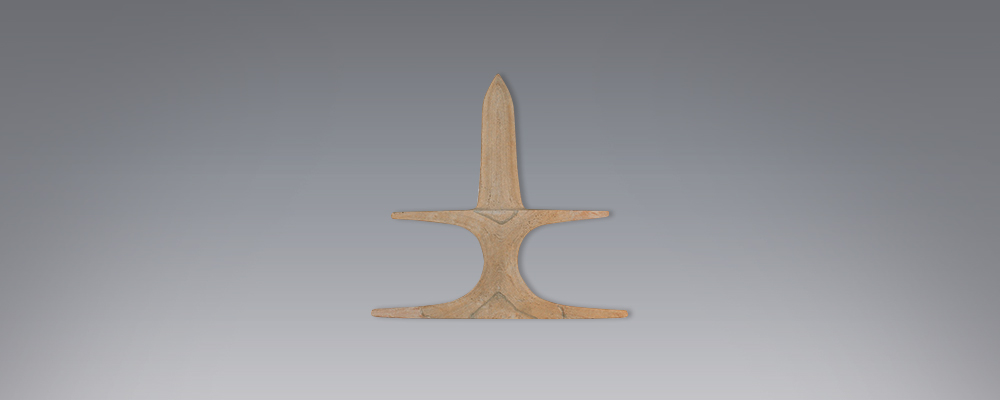
Polished stone daggers which are typically excavated from dolmens and stone coffins in Korea were used as either a weapon or ceremonial tool. They can largely be divided into a pommel type, where the body of the dagger and a pommel were produced as one, and a tang type, where the dagger had to be fitted into a wooden pommel for use. The ones where the dagger is relatively small compared to the pommel have been reprocessed. The polished stone daggers that seem very decorative with the pommel and the point of a sword extending toward the side are speculated have been produced as funerary objects.
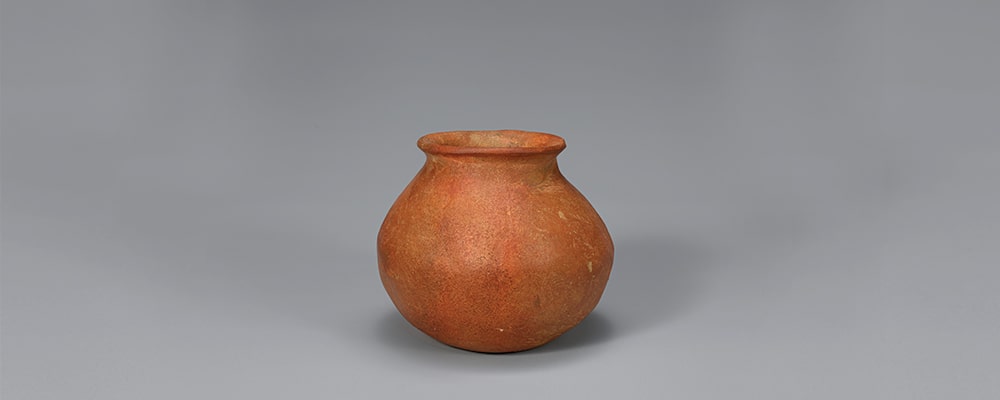
This is a type of pottery with a red glossy finish that was achieved by applying iron oxide on the surface prior to firing. Such wares are deemed to have been used for special purposes such as ceremonial occasions, and although they are typically found in tombs, they have been excavated from housing sites as well. Those with everyday uses include bowls with flat bottoms, jars and plates, but the ones used as funerary objects are mostly jars with round bottoms.

Obsidian is a volcanic rock whose name in Korean means a “black, shiny rock.” It is formed when lava flowing from a volcanic eruption rapidly cools on the Earth’s surface. Because it can be easily split into sharp edges, it was mainly used to make arrowheads. Obsidian arrowheads dating from the Neolithic period are commonly found on the south coast and the northeastern region, and their origins can be traced back to Baekdusan Mountain and Kyushu, Japan.

Bronze daggers can be divided into Liaoning-style daggers and Korean-style daggers, based on the regions where they were excavated. This particular sword is Korean-style sword, and this type is also known as a slim bronze dagger because of its slim shape. One of the most notable characteristics of Korean bronze daggers is that, unlike the bronze daggers from China or northern regions, the body of the dagger and the pommel were made separately and assembled together.

In the archeological sites of Samhan and Gaya, where beads were considered precious, a wide variety of glass and crystal has been found. Because crystals are hard, it was difficult to grind and polish them into a round shape or a multi-faceted shape. This particular crystal necklace found in Yangdong-ri, Gimhae is the largest and most beautiful crystal found to date.

This is a buckle that was used to join the ends of a belt made of leather or cloth. The hook extending from the side of the animal’s chest was used to connect to one end of the belt. A belt buckle in the shape of a tiger has also been found. Such animal-shaped buckles have mostly been excavated in China and northern regions.
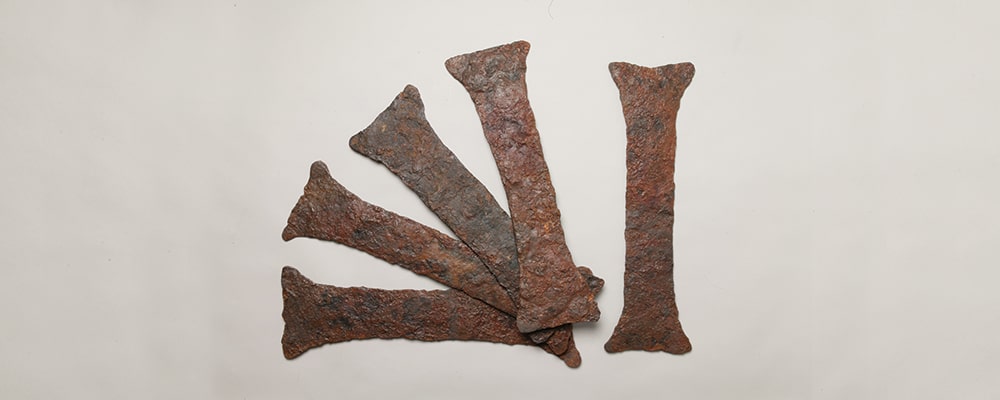
This is an iron plate made by flattening a piece of iron into a long rectangular shape, with some having a slender middle part. Iron ingots were used to make iron wares such as axes and spears. They varied in size, shape and weight and were used as currency. Based on the fact that the iron ingots were buried in clusters of ten in the tombs of the ruling class, it was determined that the people of Gaya used the decimal system.

Some of the more important characteristics of a sword are sharpness and robustness. Swords were used not only in combat but also as tools displaying the social status of the user based on the decorations on the handle or scabbard. Unlike the swords with just a round loop, this particular sword features decorations depicting a dragon and a phoenix in the round loop, thereby demonstrating the power and authority of its owner.

This has been named so because of the fern-shaped scales on the edge of the thin iron plate. Because of the presence of a hole through which a wooden pommel can be inserted, it is deemed that it could have been used as a weapon in war to be thrown around the enemy riding a horse and topple him over. Scales decorated in a bird design, rather than a fern design, are more decorative and thus regarded to have been used by certain members of the ruling class.

This is a gilt-bronze crown that was excavated from Tomb No. 11 in Bokcheon-dong, Busan. It was adorned with a combination of wave and dot patterns on the edge of the thin round base, while there are three side branches extending from the branched ornaments and it even features spangles for ornamental purposes. The gilt-bronze crowns of Gaya feature a simpler design that is reminiscent of tree branches compared to the more elaborate gold crowns of Silla. They are similar in appearance to the early designs of Silla’s gold crowns in the shape of 山, and the method of securing the round base of the crown and the ornaments with gold nails was also applied. Unlike Silla, however, Gaya only had gilt-bronze crowns and no gold crowns.

This pottery ware dating from the mid-4th century was found in the Seok-dong Archaeological Site in Changwon. Measuring 17.6cm in height and 12cm in width, it is in the shape of a two-story home with nine pillars and a gable roof. A door can be seen in the front. In the middle of the roof-shaped top, there is an inlet into which liquid could be poured, while an outlet can be found in front of the door. Based on this, it is deemed that it was used to hold and pour liquid. It can hold up to 350ml of liquid.
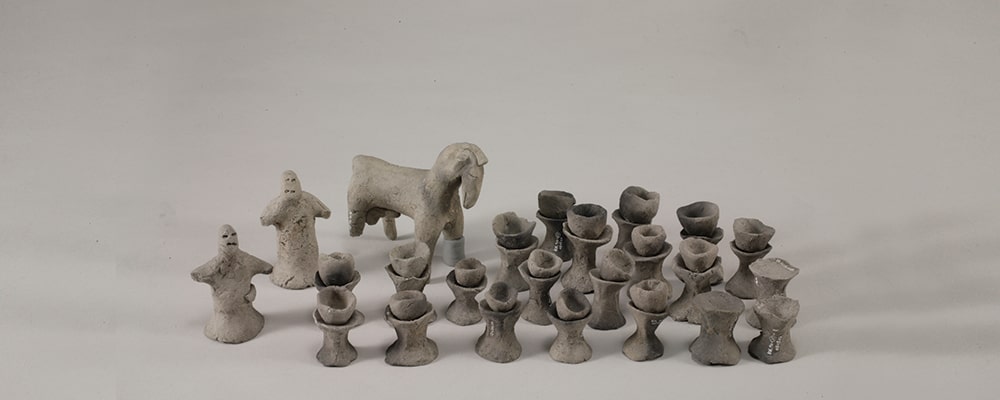
Some 20 pieces of small clay figurines, cups and saucers in the shape of humans and horses were found in the reservoir of Bonghwang-dong in Gimhae. They depicted people’s faces, a woman with a belt, and horses with excessively large genitals. These artifacts, which are smaller than cups and saucers that were actually used, have mainly been excavated from archaeological sites associated with rites and ceremonies.

This was a farming tool used to weed a field or to make a small ditch for water to flow into a rice paddy. It has a Socketed Spearhead for the wooden handle. This is an agricultural tool that is unique to Korea, and it is not commonly seen in China or Japan. Spades have been buried in the tombs of ruling class, so they have a symbolic meaning in that the ruling class governed over the people by dominating over agriculture. Spades can be seen on belt decorations dating from the Three Kingdoms Period, and they were bestowed upon high-ranking officials by the king during the Joseon Dynasty.
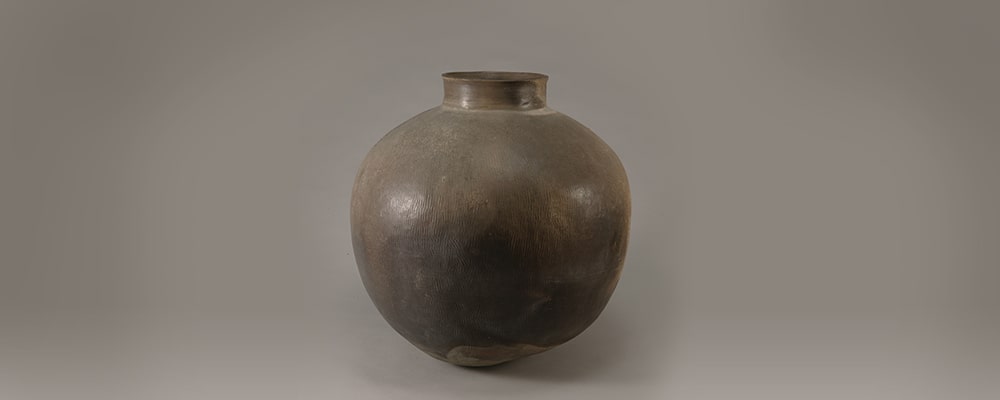
This is a jar excavated from Stone-Lined Tomb No. 34 on Marisan Mountain in Haman that is reminiscent of a white porcelain moon jar. On the surface, there remain traces left behind by tapping the surface with a tool. It is larger and thicker than the typical Gaya pottery and is therefore heavier. Tomb No. 34 is speculated to have been built in the late 5th century. Featuring a unique layout with five chambers, five to six individuals were buried there.
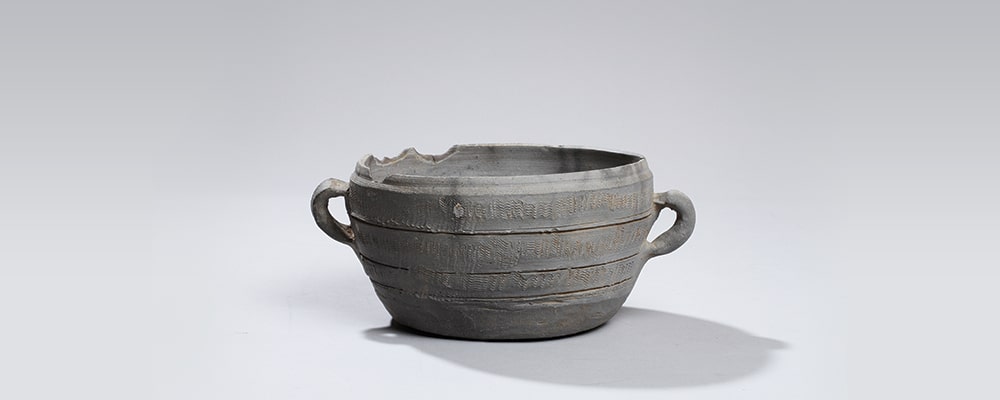
This is a typical Daegaya pottery ware that was uncovered from an archaeological residential site in Hachon-ri, Sancheong. Engraved on the bottom of the pottery is three Chinese characters, “二得知 (Ideukji).” According to ancient records, “得 (Deuk)” and “知 (Ji),” were mainly used in people’s names. For instance, a Gaya figure whose name ended with the character, “知 (Ji),” was Haji (荷知), the king of Gara-guk, and there remain records that he was appointed the Patriotic General and the King of the State by the Southern Qi of China.

These are the dish stand and jar excavated from a stone-lined tomb in Bokcheon-dong. On the dish stand, there is a turtle appearing as though it is climbing up. On the back of its shell, there are patterns consisting of thin lines, instead of hexagonal shapes. This type of cylinder-shaped dish stand has been found inside tombs as well as fiefs and ditches acting as drainage along the rocks placed around a tomb. For this reason, it is speculated to have been associated with memorial services.
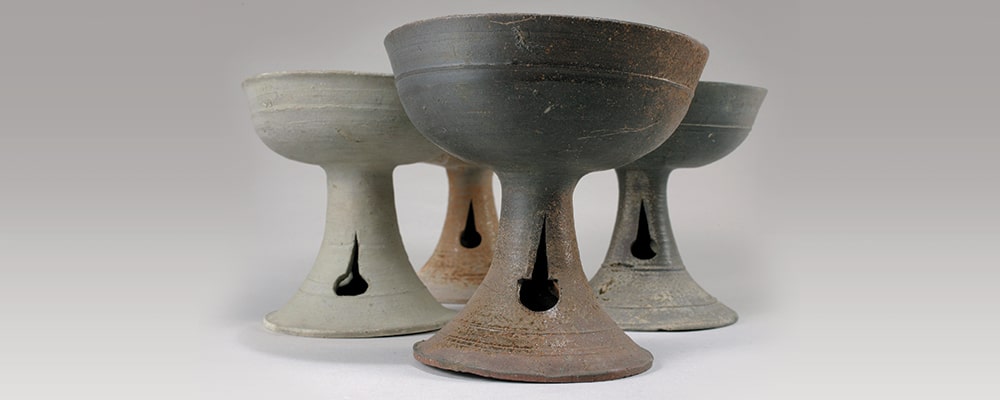
Mounted dishes feature holes in diverse shapes or patterns on the mount that are unique to their respective regions. This particular mounted dish has an opening in the shape of a flame which was popular in Ara Gaya, which was located in the present-day Haman. Cylindrical mounted dishes and flame pattern mounted dishes were popular in the region in the 4th and 5th centuries, respectively.

This type of pottery with a horn-shaped cup on top of a mount and wheels on both sides was commonly made in Ara Gaya. This was used on special occasions such as ancestral rites, and it is deemed to have a symbolic meaning in that, together with boat-shaped pottery, it conveyed the people’s wishes for the spirit of the deceased to cross over into the other world in peace and comfort.

This is a helmet made by connecting several pieces of thin and long iron plates vertically. It appears as though a bowl is attached upside down at the crown, and this is referred to as the “Vertical Plate Helmet.” There are cheek covers found on the left and right sides of the helmet.

Long iron plates were put together using nails. Although the iron plates have rusted, when they were originally made, they effectively blocked arrows. The iron plates were coated with otchil (lacquer) and even decorated with bird feathers. On the nape area, there are two birds facing the opposite directions, with their tails pointing toward each other.

Even the horses used in battle were protected by armors and helmets. Horse helmets were comprised of three parts: a face cover, a brim that shielded the top of the head and ears, and cheek covers. The face and cheek covers were tied with leather straps, while the other parts were connected using nails.
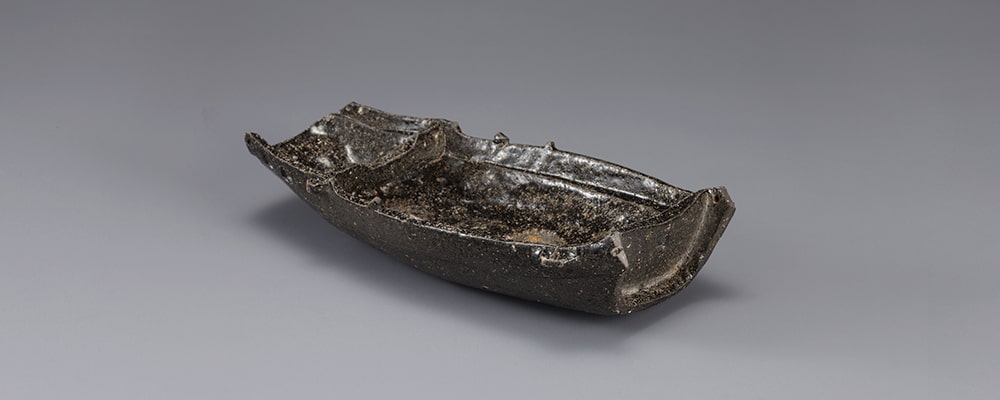
This is the first boat-shaped pottery ware found in the area occupied by Gaya. To be more specific, it was excavated from a chamber tomb located in Yeorae-ri, Jinyeong-eup, Gimhae. Measuring 22.5cm in length, 10.5cm in width and 4.5cm in height, it was attached with a wooden board. There are two oarlocks on the left and right sides each, and the yoke, which could be described as the beam of the boat, is only found in the front part of the boat. Together with the fragments of Gaya boats found at the Bonghwang-dong Archaeological Site in Gimhae as well as the boat-shaped pottery found at the Hyeon-dong Archaeological Site in Masan, this provides important information for research on the structures of boats, which served an important role in the maritime trade of Gaya.

Bronze pots in this shape were mainly used by nomads in the northern plains. In China, they were used from the late Western Zhou period until the Six Dynasties period, and in Korea, they have been excavated from the archaeological sites in Nangnang in Pyongyang and Daeseong-dong and Yangdong-ri in Gimhae. The body of this bronze pot is long, and it has a thin handle. Of particular note, this pot contained three chestnuts when it was found.
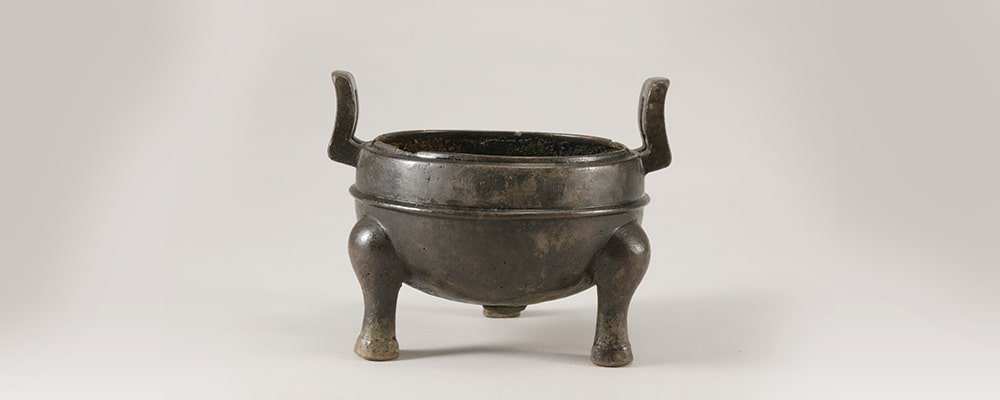
This is a bronze pot that was made in the basin of the Yellow River in China between the 1st Century BC and the 1st century AD. It is speculated to have been transferred to Gaya at a later time and buried in the chamber tomb in the 3rd century. Weighing 2.3kg with a volume of 1.98ℓ,it can hold more liquid than a regular soda bottle. There are traces that show the bottom part of the pot and one of the legs have been previously repaired. It is deemed that it was used for ceremonial occasions such as a rite or for measuring the volume of certain goods. It is engraved with 14 letters which are “西□宮鼎容一斗幷重十七斤七兩七.”